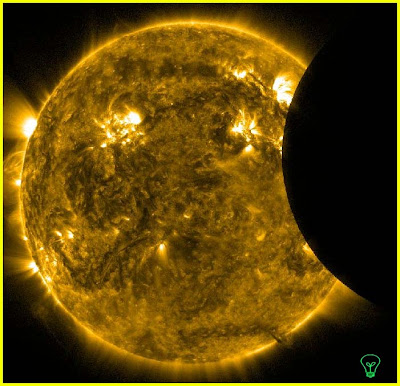
A NASA spacecraft has detained footage of Tuesday's partial solar eclipse. NASA's Solar Dynamics Observatory (SDO) captured images of the new Moon crossing part of the Sun's face in a incomplete eclipse that was visible only from space. For more information about solar eclipses, check out an online high school to find science classes that can teach you how solar eclipses happen and its significance to sun-earth interactions.
Space.com reports that SDO snapped a video and photos of the solar eclipse which made the Sun look like a "huge celestial Pac-Man," from a position 22,000 miles (36,000 kilometers) above the Earth. According to SDO , "The video shows today's Lunar Eclipse in a variety of wavelengths the AIA instrument observes. Each wavelength shows us a different temperature and layer of the Sun, allowing us to study the Sun and its activities."
SDO officials tweeted a message on the mission's mascot Twitter account, @Camilla_SDO: "It's a PacMan sun! The moon is transiting between @NASA_SDO and the sun today!"
The incident, according to SDO officials, caused a dip in EVE (extreme ultraviolet) output and gave scientists opportunity to calibrate the energy emitted by the active sunspot region AR1422 that has been emitting strong ultraviolet radiation into space. The AR1422 region was blocked in the Moon's passage across the face of the Sun.
An eclipse occurs when the moon passes between the Earth and the Sun. A total eclipse occurs when there is an exact alignment between the Moon and the Sun as viewed from the Earth. When the alignment is not exact, we have a partial eclipse. Space.com reports a total eclipse will take place on November 13, but will be visible only from parts of northern Australia and the South Pacific. A partial eclipse will occur on May 20 and will be visible in much of Asia, the Pacific and western North America, says NASA.
Thanks: digitaljournal.com
Halloween Costumes
Space.com reports that SDO snapped a video and photos of the solar eclipse which made the Sun look like a "huge celestial Pac-Man," from a position 22,000 miles (36,000 kilometers) above the Earth. According to SDO , "The video shows today's Lunar Eclipse in a variety of wavelengths the AIA instrument observes. Each wavelength shows us a different temperature and layer of the Sun, allowing us to study the Sun and its activities."
SDO officials tweeted a message on the mission's mascot Twitter account, @Camilla_SDO: "It's a PacMan sun! The moon is transiting between @NASA_SDO and the sun today!"
The incident, according to SDO officials, caused a dip in EVE (extreme ultraviolet) output and gave scientists opportunity to calibrate the energy emitted by the active sunspot region AR1422 that has been emitting strong ultraviolet radiation into space. The AR1422 region was blocked in the Moon's passage across the face of the Sun.
An eclipse occurs when the moon passes between the Earth and the Sun. A total eclipse occurs when there is an exact alignment between the Moon and the Sun as viewed from the Earth. When the alignment is not exact, we have a partial eclipse. Space.com reports a total eclipse will take place on November 13, but will be visible only from parts of northern Australia and the South Pacific. A partial eclipse will occur on May 20 and will be visible in much of Asia, the Pacific and western North America, says NASA.
Thanks: digitaljournal.com
Halloween Costumes